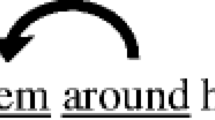Abstract
Researchers investigating eye movements during reading often follow a strategy of letting theoretical considerations tell us what locations in text to focus on in analyzing the eye movement record. We attempt to draw conclusions about processing at these locations by considering results obtained with several different measures. Some of the measures we use are first fixation duration, gaze duration, probability of fixating a target word, number of fixations on a target word, length of saccades off a target word, and spillover effects (effects on words following a target word). We have argued in several places (Rayner & Pollatsek, 1987, 1989; Rayner, Sereno, Morris, Schmauder, & Clifton, 1989; Schmauder, 1991) that this strategy, as well as use of multiple paradigms to test a constant stimulus set, provides researchers with converging evidence and yields a more complete picture of cognitive processes operative during reading than that obtainable using either a single measure or a single paradigm.
Access this chapter
Tax calculation will be finalised at checkout
Purchases are for personal use only
Preview
Unable to display preview. Download preview PDF.
Similar content being viewed by others
References
Balota, D.A., Pollatsek, A., & Rayner, K. (1985). The interaction of contextual constraints and parafoveal visual information in reading. Cognitive Psychology, 17, 364–390.
Blanchard, H.E., McConkie, G.W., Zola, D., & Wolverton, G.S. (1984). Time course of visual information utilization during fixations in reading. Journal of Experimental Psychology: Human Perception and Performance, 10, 75–89.
Frazier, L. (1990). Exploring the architecture of the language-processing system. In G.T. Altmann (Ed.), Cognitive models of speech processing: Psycholinguistic and computational perspectives (pp. 409–433). Cambridge, MA: MIT Press.
Henderson, J.M., & Ferreira, F. (1990). Effects of foveal processing difficulty on the perceptual span in reading: Implications for attention and eye movement control. Journal of Experimental Psychology: Learning, Memory, and Cognition, 16, 417–429.
Inhoff, A.W. (1989a). Parafoveal processing of words and saccade computation during eye fixations in reading. Journal of Experimental Psychology: Human Perception and Performance, 15, 544–555.
Inhoff, A.W. (1989b). Lexical access during eye fixations in reading: Are word access codes used to integrate lexical information across interword fixations? Journal of Memory and Language, 28, 444–461.
Inhoff, A.W. (1990). Integrating information across eye fixations in reading. Acta Psychologica, 73, 281–297.
McConkie, G.W., Kerr, P.W., Reddix, M.D., Zola, D., & Jacobs, A.M. (1989). Eye movement control during reading: II. Frequency of refixating a word. Perception and Psychophysics, 17, 578–586.
Morris, R.K., Rayner, K., & Pollatsek, A. (1990). Eye movement guidance in reading: The role of parafoveal letter and space information. Journal of Experimental Psychology: Human Perception and Performance, 16, 268–281.
Morrison, R.E. (1984). Manipulation of stimulus onset delay in reading: Evidence for parallel programming of saccades. Journal of Experimental Psychology: Human Perception and Performance, 10, 667–682.
O’Regan, J.K. (1990). Eye movements and reading. In E. Kowler (Ed.), Eye movements and their role in visual and cognitive processes. Vol. 4 of Reviews of Oculomotor Research. Amsterdam: Elsevier.
O’Regan, J.K. (1981). The convenient viewing position hypothesis. In D.F. Fisher, R.A. Monty, & J.W. Senders (Eds.), Eye Movements: Cognition and visual perception. Hillsdale, NJ: Erlbaum.
O’Regan, J.K., & Levy-Schoen, A. (1987). Eye movement strategy and tactics in word recognition and reading. In M. Coltheart (Ed.), Attention and performance XII: The psychology of reading (pp. 363–383). Hillsdale, NJ: Erlbaum.
Pollatsek, A., Lesch, M., Morris, R.K., & Rayner, K. (1992). Phonological codes are used in the integration of information across saccades in word identification and reading. Journal of Experimental Psychology: Human Perception and Performance, 18, 148–162.
Pollatsek, A., & Rayner, K. (1982). Eye movement control in reading: The role of word boundaries. Journal of Experimental Psychology: Human Perception and Performance, 8, 817–833.
Rayner, K. (1979). Eye guidance in reading: Fixation locations within words. Perception, 8, 21–30.
Rayner, K., McConkie, G.W., & Zola, D. (1980). Integrating information across eye movements. Cognitive Psychology, 12, 206–226.
Rayner, K., & Pollatsek, A. (1987). Eye movements in reading: A tutorial review. In M. Coltheart (Ed.), Attention and performance XII: The psychology of reading (pp. 327–362). Hillsdale, NJ: Erlbaum.
Rayner, K., & Pollatsek, A. (1989). The psychology of reading. Englewood Cliffs, NJ: Prentice Hall.
Rayner, K., Sereno, S.C., Morris, R.K., Schmauder, A.R., & Clifton, C. (1989). Eye movements and on-line language comprehension processes. Language and Cognitive Processes, 4, SI 21–49
Schmauder, A.R. (1991). Argument structure frames: A lexical complexity metric? Journal of Experimental Psychology: Learning, Memory, and Cognition, 17, 49–65.
Vitu, F., O’Regan, J.K., & Mittau, M. (1990). Optimal landing position in reading isolated words and continuous text. Perception and Psychophysics, 47, 583–600.
Editor information
Editors and Affiliations
Rights and permissions
Copyright information
© 1992 Springer-Verlag New York Inc.
About this chapter
Cite this chapter
Schmauder, A.R. (1992). Eye Movements and Reading Processes. In: Rayner, K. (eds) Eye Movements and Visual Cognition. Springer Series in Neuropsychology. Springer, New York, NY. https://doi.org/10.1007/978-1-4612-2852-3_22
Download citation
DOI: https://doi.org/10.1007/978-1-4612-2852-3_22
Publisher Name: Springer, New York, NY
Print ISBN: 978-1-4612-7696-8
Online ISBN: 978-1-4612-2852-3
eBook Packages: Springer Book Archive




